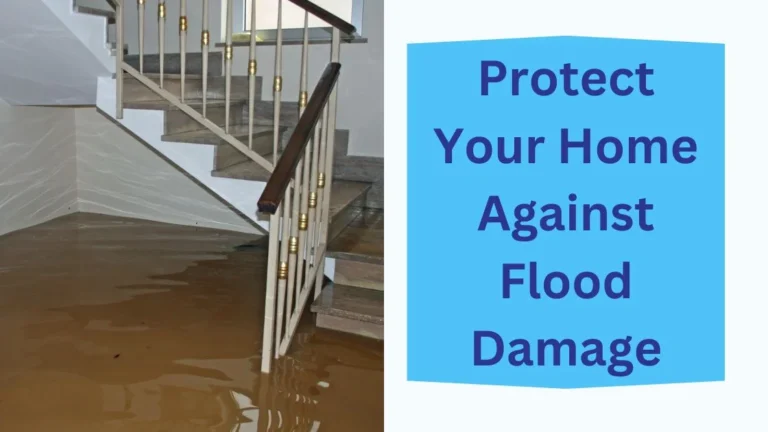Flooding can cause significant destruction to homes, leading to financial strain and emotional distress. Taking proactive measures is essential to minimise the risk of flood damage and protect your property. In this article, we’ll discuss effective strategies to shield your home against the threat of flooding. By implementing these preventative steps, you can enhance your home’s resilience and ensure peace of mind during adverse weather conditions.
- To effectively protect your home against flood damage, start by assessing your flood risk using local flood maps and historical data.
- Elevate your property and critical utilities to reduce vulnerability. Install barriers such as flood gates and ensure efficient drainage systems are in place to divert water away from your foundation.
- Using flood-resistant materials in construction is crucial for resilience. Educate your household on emergency preparedness and keep an emergency kit ready for swift action during flooding.
- Engaging with community resources can enhance your flood readiness and response strategies. Exploring these measures further will uncover even more effective tactics to safeguard your home.
Understanding Flood Risk
Understanding flood risk is essential for homeowners, particularly those residing in vulnerable areas. Effective flood mapping is a valuable resource for identifying whether your property lies within designated flood zones, highlighting susceptibility linked to geographical location and climate impact.
By examining historical data on past flooding events, homeowners can gain insights into the frequency and severity of potential risks, thus enhancing preparedness. Furthermore, evaluating your property’s elevation in relation to nearby water bodies is vital; lower elevations increase vulnerability during heavy rainfall or storm surges.
Engaging with local flood agencies can further enrich your understanding, providing tailored assessments based on specific property characteristics and surrounding environmental factors. Awareness of these elements fosters a sense of community and collective resilience.
Related: What Are the Causes of Household Floods?
Assessing Your Property
Assessing your property for flood risk is a vital step in protecting your home and investment. Begin with an elevation assessment to ascertain how your property compares to nearby water bodies, as lower-lying homes are more vulnerable to flooding. Use local flood risk maps to determine if your property falls within a designated flood zone.
Also, examine your property for minor defects that could allow water ingress during flooding events. Engaging professional surveyors for a flood survey can provide tailored recommendations for your specific vulnerabilities.
| Assessment Type | Purpose |
|---|---|
| Elevation Assessment | Determine flood susceptibility |
| Local Flood Maps | Identify flood zone status |
| Property Inspection | Spot potential water ingress points |
| Professional Survey | Tailored flood protection recommendations |
| Historical Research | Gauge frequency and severity of past floods |
Ultimately, researching historical flood events in your area will help you comprehend past risks and prepare for future threats. Discover more strategies to ward off water leaks.
Essential Flood Prevention Measures
Flood prevention measures are essential for safeguarding homes against the devastating impact of rising waters. Implementing elevation techniques, such as constructing homes on stilts or raising foundations, considerably minimises flood risk, particularly in vulnerable areas.
Moreover, barrier installations, including permanent flood gates and walls, provide robust protection against encroaching water. Regular maintenance of these barriers guarantees their effectiveness during critical times.
Effective drainage management is equally important; clearing gutters and installing sump pumps helps divert rainwater away from foundations, reducing the risk of accumulation.
In addition, employing flood-resistant materials in construction, such as waterproof compounds and elevated electrical systems, can mitigate damage during flooding events.
Strategies for Different Flood Types
Understanding the unique challenges posed by different types of flooding is essential for effective home protection.
Surface flooding requires creative landscaping solutions, while flash floods necessitate rapid response measures and community education.
For river flooding, robust infrastructure such as levees and flood-resistant materials can significantly enhance a home’s resilience against rising waters.
Surface Flooding Solutions
Surface flooding presents a considerable challenge for homeowners, especially during heavy rainfall events.
Implementing effective solutions can greatly mitigate these risks. Consider the following strategies:
- Swale design to channel rainwater away from foundations
- Permeable materials for driveways and pathways to enhance water absorption
- Regular gutter maintenance to prevent blockages and overflow
- Rain gardens planted with native vegetation to absorb excess moisture
- Installing a sump pump in basements to manage accumulated water
Flash Flood Preparedness
How can homeowners effectively prepare for the unpredictable nature of flash floods?
By recognising early warning signs, such as rapidly rising water levels and changes in river flow, residents can act swiftly.
Installing flood barriers or levees in vulnerable areas adds a crucial layer of protection.
Educating all household members on designated evacuation routes and safe locations is essential for coordinated responses during emergencies.
Furthermore, maintaining an emergency kit stocked with essentials like torches, batteries, and non-perishable food ensures readiness.
Regularly signing up for local flood alerts will provide timely notifications, allowing families to take decisive action.
River Flood Mitigation Techniques
Recognising the varied nature of river flood events is critical for homeowners seeking effective mitigation strategies.
Implementing a combination of proactive measures can greatly reduce flood risk and safeguard your home.
- Construct sturdy levees and flood walls to redirect water away.
- Raise critical utilities like electrical panels above base flood elevation.
- Employ proper grading and landscaping to enhance natural drainage.
- Install check valves in plumbing systems to prevent sewer backups.
- Regularly maintain drainage systems, ensuring gutters and downpipes are clear.
Long-Term Flood Preparedness
Effective long-term flood preparedness is crucial for safeguarding homes and communities against the increasing threat of flooding. Regularly evaluating and updating flood risk assessments in conjunction with local flood maps ensures that families remain informed and proactive.
A comprehensive Flood Action Plan, detailing steps to take during a flood event, minimises damage and enhances safety. Investing in flood-resistant construction materials and elevating critical systems can significantly reduce future flooding impacts.
Engaging with community resources and local authorities fosters collaboration, enhancing resilience through shared knowledge. Furthermore, continuous education on flood risks and maintaining an emergency kit stocked with essential supplies bolster individual and collective preparedness.
Don’t forget the importance of flood insurance and effective risk communication in this ongoing effort.
Importance of Professional Evaluations
Long-term flood preparedness lays the groundwork for effective flood management, but the complexity of flood risks necessitates professional evaluations to further enhance resilience. Engaging with qualified professionals offers substantial evaluation benefits, ensuring your home is adequately protected against flood damage.
- Customised flood protection recommendations
- Identification of minor defects before they escalate
- Compliance with British Standards (BS 851188)
- Insightful Due Diligence Reports for potential improvements
- Adaptation strategies for changing environmental conditions
These expert insights not only reinforce existing defences but also empower homeowners to make informed decisions.
Post-Flood Recovery Actions
In the aftermath of a flood, swift and informed actions are essential for effective recovery and restoration.
Firstly, contact your insurance company immediately to initiate the claims process and understand the documentation needed for coverage.
Prioritise safety by ensuring emergency services confirm it is safe to return to your property before evaluating damage.
Arrange for safety inspections of utilities—gas, water, and electricity—to identify hazards and confirm systems are safe for reactivation.
During repairs, consider implementing flood resilience measures, such as using flood-resistant materials and elevating utilities, to mitigate future risks.
Furthermore, investigate participation in the Flood Re Build Back Better scheme for financial support aimed at enhancing your home’s flood resilience post-recovery.
Community Resources and Support
Community resources and support play an essential role in enhancing flood preparedness and resilience. Local councils and organisations provide valuable tools and knowledge, fostering a sense of belonging among residents.
- Community workshops on flood preparedness
- Flood mapping initiatives to assess risk
- Free flood warning services via phone or email
- Affordable flood insurance programmes through Flood Re
- Grants for home improvements from environmental agencies
These resources empower individuals to take proactive measures, ensuring their homes and families are better protected against flooding.
Key Takeaways
- Assess your property’s elevation and flood zone designation using local flood maps to understand vulnerability.
- Implement effective drainage systems and maintain gutters to divert rainwater away from your home’s foundation.
- Elevate critical utilities and use flood-resistant materials in construction to minimise potential flood damage.
- Install barriers such as flood gates and levees to provide additional protection against rising water levels.
- Stay informed through community resources and local flood alerts to prepare for potential flooding events.
Has a flood invaded your property?
Northern Ireland’s leading Loss Assessor service is here to help manage your flood damage claim and secure the settlement you’re entitled to.
Experiencing flood damage is overwhelming and stressful. Imagine having a team of specialists by your side, expertly guiding you through the complex claims process. Our experienced professionals focus on flood damage claims, ensuring your case is handled with precision and efficiency.
Think of the peace of mind you’ll gain knowing that a dedicated expert is advocating for your best interests, negotiating your settlement offer, and managing all the detailed paperwork. Our comprehensive approach allows you to concentrate on restoring your property while we take care of your claim.
Don’t let flood damage claims add to your stress. Contact PCLA, Northern Ireland’s trusted Loss Assessor service today for a free consultation.



